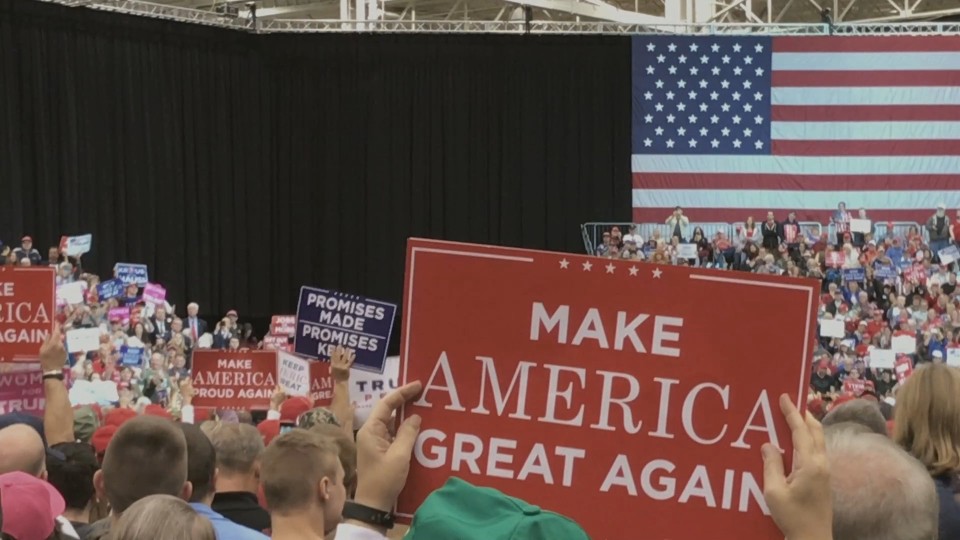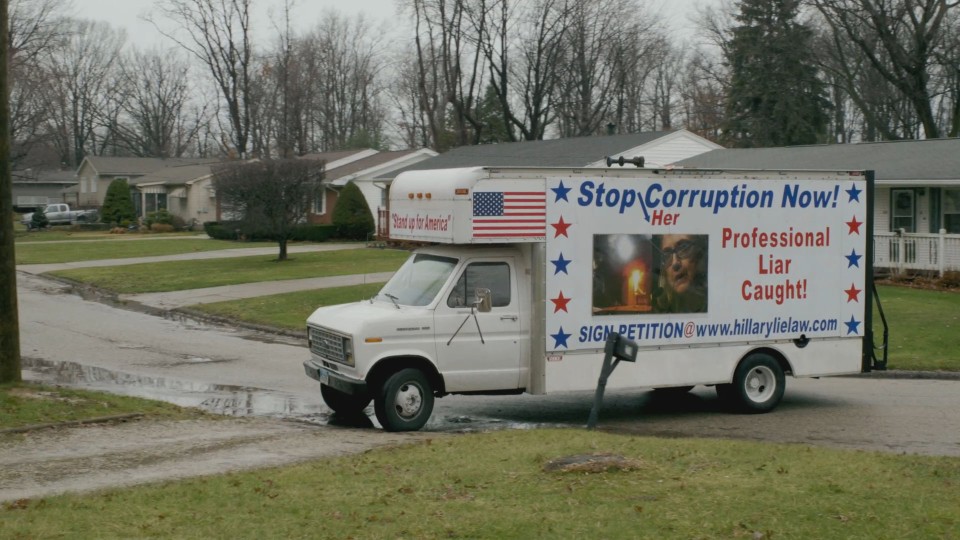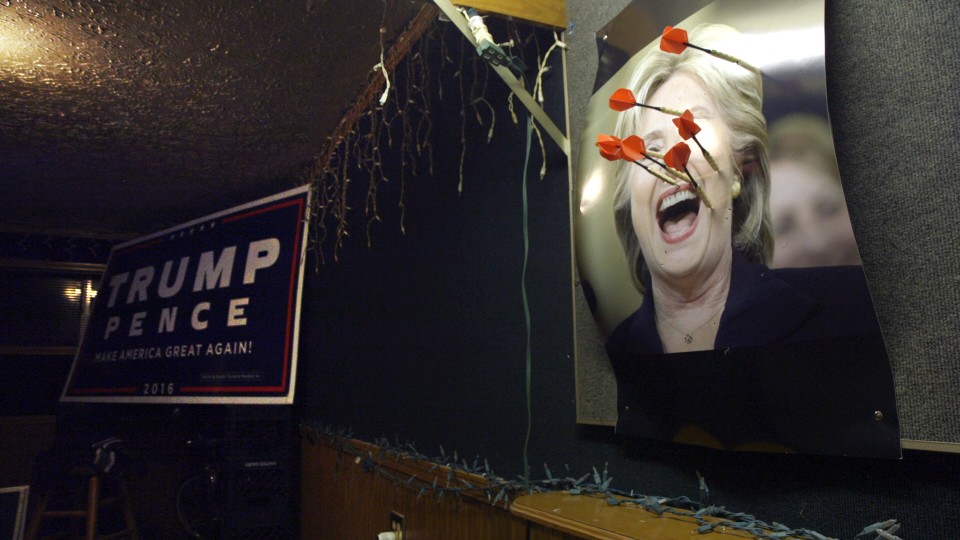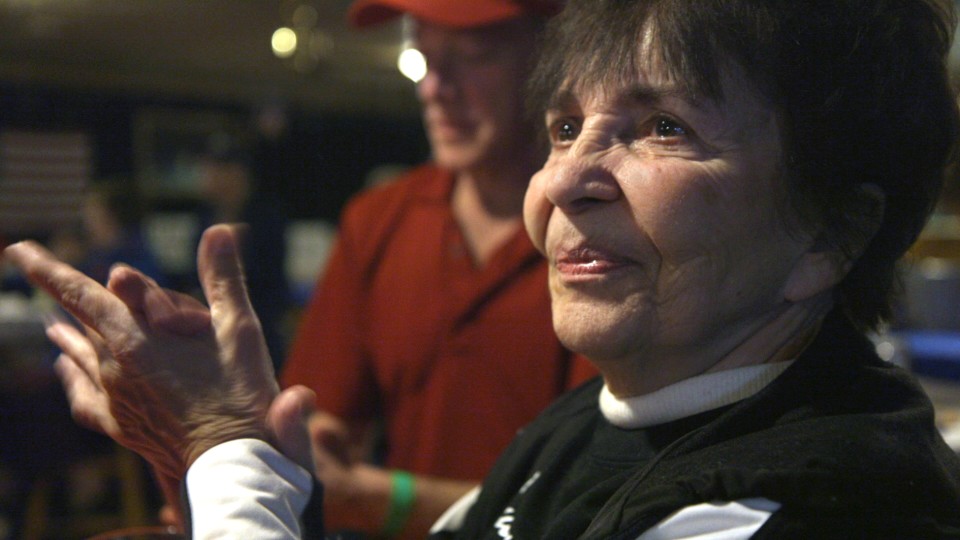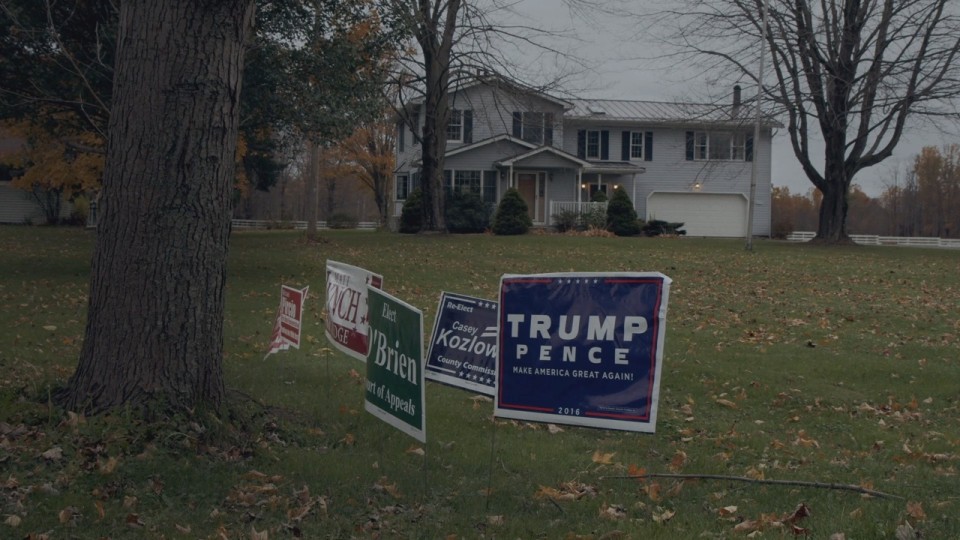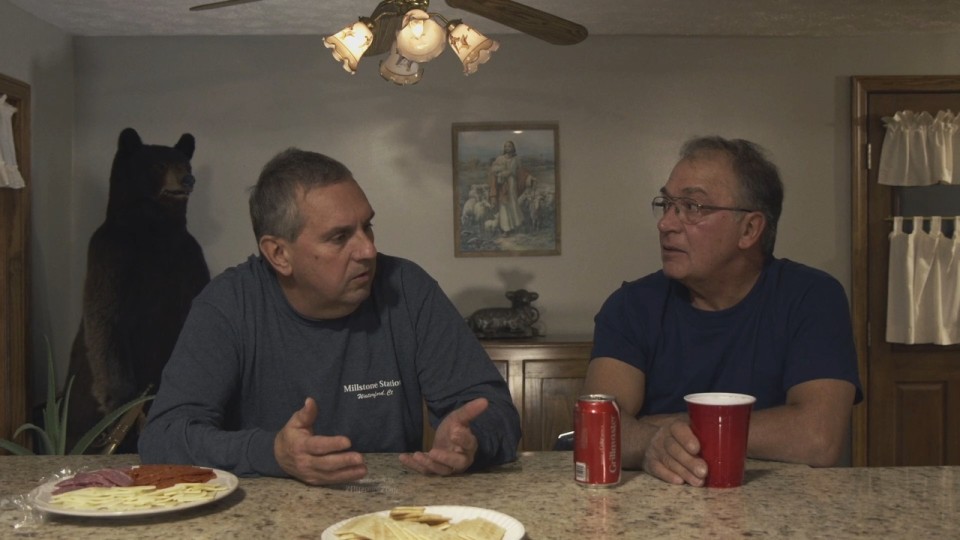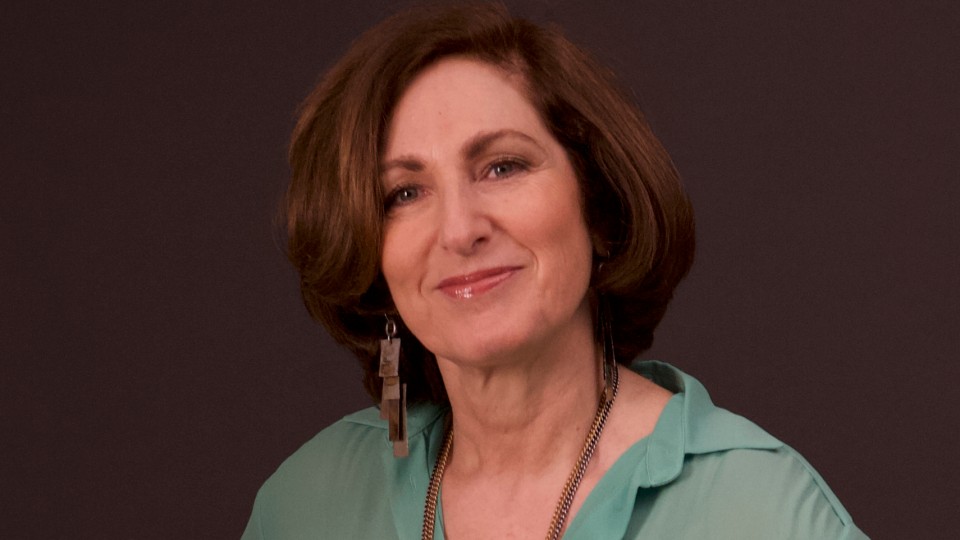Susanne Brandstätter was among the many people for whom 9 November 2016 brought a rude awakening. She too had been planning
to watch Hillary Clinton's acceptance address early that morning, only to discover that the country of her birth had chosen
Donald Trump as the 58th President of the USA. On the day of his inauguration two months later the filmmaker was already in the swing state of Ohio,
to capture the euphoria among Trump voters and ask them about their motives. THIS LAND IS MY LAND is a film that listens.
Donald Trump was elected US-President in November 2016. In January, just in time for the inauguration ceremony, you were in
the USA to start shooting your film THIS LAND IS MY LAND. As a native American, what about this election result triggered
you to react so spontaneously?
SUSANNE BRANDSTÄTTER: Just like everybody else, I expected that Hillary Clinton would win – I got up very early the day after the election to see
the results. I just wanted to see what the numbers were. I was so shocked. I really couldn’t believe my eyes. I just couldn’t
understand what had happened in my homeland. I talked to a lot of friends and one of them said to me, “Susanne, as someone
born in America and living in Austria for so long, you’re predestined to make a film about this.” Actually, I’ve been living
in Europe my whole adult life. The more I thought about it, I realized she was right. I wanted to understand what happened.
That was the first motivation and I knew I had to get there soon and be there for the inauguration. I went to the States for
research before the team and they followed. I knew if I didn’t react immediately, these historical moments would be gone forever.
I wanted to capture the euphoria, when Trump was being inaugurated. Fortunately, I found a possibility of doing that with
my team, who was very supportive.
Ohio was your destination. Why did you choose this state among the numerous swing states that might also have been an option?
SUSANNE BRANDSTÄTTER: I actually looked at all the different swing states and then I decided on Ohio. It’s a swing state that is in the rust belt,
where so many factories had to close down – people there went through enormous difficulties during the financial crisis. So
many were out of jobs and there were a lot of problems in Ohio because of that. During my research, I also discovered that
the largest factory that produced American flags was located in Ohio. All that, plus the impressive images of the countryside
and the decline of the small towns, helped me decide on Ohio.
You already shot on the day of the president's swearing-in. This shoot can only have been preceded by rather short research
for suitable protagonists. How did you look for interview partners? What criteria did they have to fulfill? Was it part of
your concept to shoot more than once?
SUSANNE BRANDSTÄTTER: It was always planned that I would shoot for a longer time. We shot three times. If I had had more money, I would have shot
even one more time. I did extensive research from Austria first and of course everything had to go quite quickly. I found
one of my protagonists through internet, before I even went there. That’s Celeste. She had posted on internet that she had
Trump-signs that people could pick up to put up in their front-yards. I owe the contact to Sharon, another of the protagonists,
to a former colleague from university, who was originally from Ohio. She wrote her high-school class and asked if anybody
in Cleveland could help me. Through Sharon, I met Lauri and her husband, who are both Trumpers. Sharon also introduced me
to some other people. It was a snowball effect – they passed me on to others. I found Austin when we went to film the flag
factory. He was ideal as a young Trump voter. The main thing that was really important for me, was finding atypical Trump
voters – voters who were not the stereotype everybody was reading about in the mainstream media. The big surprise with the
election came about, because so many people who had always voted Democratic all of a sudden voted for Trump. Or immigrants.
Or women, who nobody expected to vote for Trump after his sexist remarks etc. I was looking for people that didn’t fit the
stereotype of older, uneducated, working-class white men.
As we learn during the conversations, the choice between Donald Trump and Hilary Clinton created division between people and
ended friendships. Why did voting for Trump mean so much more than just voting Republican?
SUSANNE BRANDSTÄTTER: American elections are strongly influenced by the personality of the person who is running. It’s always been like that as
far as I can remember. Of course, the party is often important too. In the case of the last election, Trump used very emotionalizing
messages, which motivated people to vote for him. Messages that often spoke to people on a subconscious level – addressing
fears they were often not even aware of. Or hopes. The motivations for voting for Trump are complex. The problem is, the explanation
is usually simplified – for example, like being only because of economic problems. I found in talking to the voters that it
was very much rooted in individual reasons: just as complex and diverse as their personalities are, are their reasons to vote
for Trump. One of Trump’s strategies is to divide – which was generally not the case with other presidential elections before.
One way he does this is by putting the political establishment down, as well as by denigrating people or groups. Like many
populist politicians, he tries to create an “us” vs. “them”. In doing that, he emotionalizes his supporters, creating an “us”,
which becomes an in-group, almost like a tribe. They even call themselves “Trumpers”. Hillary Clinton only strengthened that
when she said that Trump voters were “deplorable”. Some Trump voters took that and said full of pride, “We are the deplorables”.
Trump creates this feeling of shared identity and uses these emotions of solidarity to activate and mobilize people. These
are tactics that politicians have used throughout history to motivate, instrumentalize and manipulate people. To the point
that some go out onto the streets. And, as we unfortunately see happening now, this can lead to physical violence. This tactic
works, because it has to do with the way we human beings form opinions. The stronger we believe in something, the less willing
we are to back down from our opinion. Basically, all humans are like that. From an evolutionary point of view, forming an
opinion based on bias has helped us survive in dangerous situations. But there are situations where that’s not really needed
and that’s when it can become a problem.
You shot a lot inside, with people in their homes and thus also convey their lifestyle. How would you describe your protagonists
in terms of their social standing?
SUSANNE BRANDSTÄTTER: It was important for me to film the home settings, because it shows a lot about who these people are. There’s an idea that
Trump voters are so-called lower-class. Actually, a lot of Trump voters were middle-class or even upper middle-class, quite
well off. They have big cars, big houses and some of them are doing very well financially, despite the financial crisis. Other
protagonists – I’m thinking of Austin’s family, who consider themselves lower middle-class – are really struggling to get
by. It’s a family with three boys. The father works for the post office, but also holds down other jobs to try to make ends
meet. Austin had to have two jobs, because he was trying to earn enough money to be able to attend university. The idea was
to show a broad spectrum of voters from different backgrounds. Which is why I didn’t want to just show people at home, but
also their friends, colleagues or other family members. It wasn’t always easy. What I wanted to point out in THIS LAND IS MY LAND was the fact that Trump voters are not this monolithic group or type of people. I have Trump-voters who have always voted
for the Democratic party. Or somebody who is an immigrant and just became a US citizen one year before the presidential election
in 2016. Or people who were college-educated
very different people.
It is interesting to see how much language/a particular wording becomes the central element of decision-making, rather than
a question of content. Hillary Clinton's sentence “What difference does it make?”, after the Benghazi attack seems to have
been a decisive sentence for some Trump voters. Could Trump's recent remark that soldiers are "losers and suckers" elicit
similar reactions? Why is there so little discussion about fundamental questions and political issues?
SUSANNE BRANDSTÄTTER: A lot of people don’t take the time to inform themselves. Then there are others, who are very interested and inform themselves
in depth. It would be wrong to say “Americans are uninformed”. However, Trump’s political campaign is geared towards emotional
messages and slogans. Once someone is hooked emotionally, they often become less and less interested in what the actual policies
are or how they might function. Trump frequently adapts his policies according to whom he’s speaking to. Besides that, he
aims at an emotional, gut level. When someone listens to something very emotional and becomes emotional themselves, rational
thought becomes largely inhibited. This has been scientifically proven, in many studies. It has nothing to do with Trump,
it has to do with how we human beings are influenced by our emotions and how we form opinions. When our emotions come into
play, we tend to feel more affected by what we hear. We connect with that person’s message and with that person affecting
us. We believe that person. But the stronger we approve of a message, the more we begin to select one-sided information which
confirms what we already believe. This can go so far that cognitive dissonance takes place. That happens when you’re not just
selecting information that justifies your opinion, but completely tuning out whatever doesn’t uphold your point of view. You
hear that in the film again and again. No matter what Trump does or says, they find some reason to rationalize and excuse
it and still believe him. To the point that for some, he becomes almost like a religious figure, almost God-like. No matter
what you say or do, you are not going to get people who believe so strongly in someone to accept another point of view. I
did a lot of research on these mechanisms and this was one of the reasons that I decided that I had to follow the motto “Don’t
argue, listen!”. I knew if I argued, my protagonists would never open up to me. And I also knew that there would be no way
I could really get closer to them or truly understand them, if I was set on bringing up my own arguments about why I didn’t
think they were right. I heard a lot of things that were upsetting for me, but I really got to know these people, understand
them and grasp where they were coming from. This is what I really wanted. And then I wanted my viewers to go through the
same process of slowly getting to know them, getting closer to them and liking them, even though they have, what is for a
lot of us, horrendous opinions. I knew that the only way I could make this film was by following the decision to listen radically,
in depth, and not be forming counter arguments at the same time in my head.
You also step into the "on" of the camera as interviewer and discussion partner. Was this part of the concept or did it turn
out to be a necessity?
SUSANNE BRANDSTÄTTER: It was part of the concept that you would hear me sometimes and that sometimes I was going to be in the picture. Originally,
before shooting began, I thought there might be commentary on my part, but then I realized that that wasn’t good. I wanted
the viewer to connect with the protagonists. A commentary would have been counter-productive.
But there’s a scene towards the end of the film where I’m in the park with two of my protagonists and I’m bringing some counter
arguments. My concept towards the end of the film was to bring my Trumper-protagonists together with some friends or family
members who were anti-Trump. Unfortunately, there was a family situation where my protagonists had to cancel a shoot and leave
for Japan the next day, so we didn’t have enough time to shoot this conversation. That’s why I had to step in myself at the
last minute, otherwise I would have had this loose end with nobody representing a counter-position. That’s documentary. Things
like that happen.
When you shoot inside, Joerg Burger's camera does not necessarily pan to the person speaking, but stays on a person listening
to the speaker, the words remain in “off”. Why this decision?
SUSANNE BRANDSTÄTTER: I always like to do that. I often find that reactions that people have are so much more interesting than the person who normally
should be on camera because they’re speaking. That’s a concept that I often follow. I find that fascinating to see how people
are reacting to what somebody is saying.
There’s one issue, you seem very strongly interested in: the importance of the media. TV seems to be more important than social
media. How do people obtain the information they need to form their opinions?
SUSANNE BRANDSTÄTTER: Social media played a role, for example for Austin. He mentions that one of the reasons he didn’t vote for Hillary was because
he saw that Democrats were burning the American flag and doing terrible things. It makes you wonder how much of the things
he consumed on Facebook were things that really had happened or how much they had been manipulated. In other words, Facebook
pages that were created specially to influence American voters. During my research I ran into a lot of these Facebook pages.
Of course, I then did further research and tried to find out who was behind the names on those pages. The people were non-existent.
This was way before we all knew about the successful attempts by Russia and other foreign powers to manipulate the American
public. Generally, television plays a huge role. A lot of the protagonists used to inform themselves by watching different
stations, such as CNN, MSNBC, NPR – channels that are considered more progressive and left-wing. But the more you believe
Trump’s emotional messages, the more you want to hear what supports and justifies your beliefs. It becomes very uncomfortable
to listen to something that doesn’t confirm your beliefs. That has a physiological explanation: the reward center of our brains
becomes activated whenever we hear something that confirms what we already believe in. And when we hear something that doesn’t
confirm our beliefs, the fear center is activated, which triggers a very uncomfortable physical reaction. That can happen
to everyone, no matter what your political position or party is. Since you don’t like feeling uncomfortable, you start preferring
listening to the newscast that confirms what you already believe and after a while you might only listen to that one channel.
That’s why we have the protagonists who say, “We used to watch CNN, but we can’t bear it anymore. They are so against Trump”.
Now they only listen to Fox News, a channel supporting Trump. And they’ve become more opinionated.
How about the editing process? Was it difficult to create narrative arcs or did the compact structure and chronology help
to build them?
SUSANNE BRANDSTÄTTER: It was difficult. You have to really kill your darlings. At some point you have to decide which protagonists are stronger.
It was a process from one rough cut to the next. I concentrated on two aspects: on the sequences that show best how polarization
is getting stronger. And on scenes where a development became visible – this development was evident in the reinforcement
of their positions, which became the story. In the very beginning, I thought some of my protagonists would change their minds.
Then I realized that in reality they were becoming more and more entrenched in these opinions. That was the actual story that
I needed to tell. It was about looking for the scenes where you see and feel that happening and can understand how they are
becoming more extreme in their views.
As we speak, the next elections are getting closer. Have you kept in touch with your protagonists over the last months and
do you still feel that attitudes have not changed – even now, after a year that has been all but glorious for Donald Trump?
SUSANNE BRANDSTÄTTER: I’m in contact with all the protagonists. People who are for Trump generally remain Trump supporters. Even the Pew Research
Center studies have shown that with some exceptions almost all Trump supporters are still planning on voting for Trump. If
the Democrats want to win, they have to mobilize voters who did not vote previously and also make sure that those who voted
for the Democratic party get out and vote again. I think it’s also part of their strategy that the public shouldn’t feel sure
that Joe Biden is going to win. That was part of the problem in 2016: all of the polls showed that Hillary Clinton was so
far ahead that a lot of Democrats didn’t feel it necessary to go vote. The American system with its electoral college can
also hold some surprises in store. And even if Joe Biden does win, what then? Will Donald Trump concede? I have a strong feeling,
he won’t. He’s been contesting the validity of mail-in ballots; he’s been saying that the whole election is a scam, rigged
by foreign powers or by the Democrats. These are all reasons to believe that he may contest the results. I really worry what
is going to happen in the US, no matter who wins. The polarization is so great now that even if Joe Biden wins by a landslide,
it doesn’t mean that everything will be fine. There’s such animosity on both sides.
As both an American and a European, what do you see as the greatest concern of your film?
SUSANNE BRANDSTÄTTER: One of the things I want to point out in my film is how important it is to be willing to listen to people and to respect
other people’s opinions, even if they have political opinions that are highly divergent or opposite to your own. I’m not saying
this should be one-sided. Allowing discourse is part of our democratic process. This should be a two-sided process, where
both sides are willing to listen to the other. I strongly believe that this is very important for democracy in the US, but
also for ours here in Austria and in Europe. It’s not enough to just sit down with someone one time and think that’s enough
– it involves a lot of hard work. It has to be an ongoing process, which shouldn’t be left only to our politicians and our
institutions. It’s up to all of us to defend our democracy and to make sure that we don’t let people profit from division
that they sow for their own purposes.
For me THIS LAND IS MY LAND is not only a film about the US, and not only about Donald Trump’s voters. It’s about all of us. We all have our bias, our
prejudices and our worldviews. I realized that I’m not any different. I also have my own strong personal convictions – there’s
nothing that could convince me to find Trump good.
Consciously or subconsciously, we all hold our own worldview to be the best and that’s why it’s easier to discredit or dismiss
another standpoint. We gauge our actions seen from our own perspective and we can be reluctant to concede that other standpoints
have the right to exist. I don’t mean that we have to give up our deepest convictions or our worldviews. For me, it’s more
about keeping a process alive that’s committed to openness and the willingness to engage in discussion. And it’s about being
willing to listen.
Interview: Karin Schiefer
September 2020

